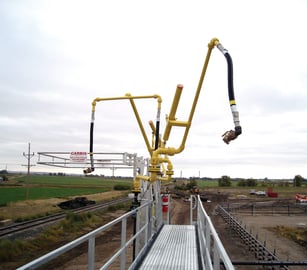 There's more than one way to load and unload product. The two most popular options for tank truck and rail cars are hoses and loading arms. Each option has its own purpose as far as moving product, ease of use and increased throughput.
There's more than one way to load and unload product. The two most popular options for tank truck and rail cars are hoses and loading arms. Each option has its own purpose as far as moving product, ease of use and increased throughput.
There are three basic types of hoses – vapor recovery, steel braided and composite.
• Vapor recovery hoses are used when lightweight and flexibility are needed. These hoses are appropriate for diesel, gasoline and lubricating oils.
• Steel braided hoses are ideal for hydraulic situations which use the dreaded combo of high heat and high temperature. They have good corrosion resistance as well as resistance to fire and abrasions. These types of hoses have to be durable and reliable, with a high degree of safety. For really high-pressure applications, two or three layers of braiding may be added. Still, the braiding is flexible and able to follow the hose’s movement.
• Composite hoses are compatible with the widest range of chemicals. They are able to transfer both polar fluids (like methanol and isopropanol) and non-polar liquids (like hexane, benzene and gasoline). Composite hoses are crafted using thermoplastic films and tubes that are wound tightly enough to create a barrier to permeation. A flexible composite hose won’t slow productivity by collapsing or kinking. It prevents sparking and arc-over hazards that may be possible with metal.
In many instances, loading arms are preferable to hoses because they have superior performance, durability and can be used in most loading/unloading applications. Loading arms can be custom made for a specific application with a choice of designs, materials and sizes. They can handle refrigerated or heated products, liquefied gases, toxic or corrosive substances.
Another reason loading arms are often preferable to hoses is because of their reliability, low maintenance and long life. Loading arms don’t require hydrostatic testing like hoses do. They also have few spare parts, minimal spillage waste, don’t create trip hazards and provide better safety because they won’t burst.
Of course there will be times when hoses are the best choice for the job. Hoses are more flexible than loading arms but are more likely to wear out due to weather exposure combined with being dragged across concrete. Hoses are heavy, bulky and can create a fall hazard. Because they need replacing often, they are also a constant cost.
Loading arms protect workers and the environment against the devastating effects of hose rupture, pull-apart and failure. They also make quicker connections and load/unload faster meaning better throughput for the company.
Learn common rail safety challenges that affect many worksites by downloading this free tipsheet from Carbis Solutions.




